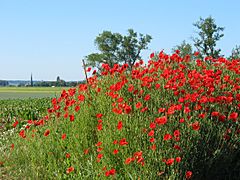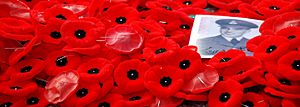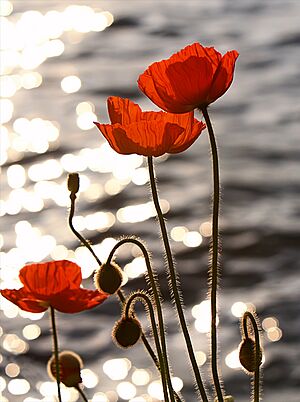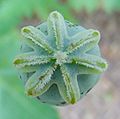Poppy facts for kids
A poppy is a beautiful flowering plant that belongs to the Papaveroideae group within the Papaveraceae family. Poppies are usually herbaceous plants, meaning they have soft stems instead of woody ones. People often grow them because of their bright, colorful flowers.
One special type of poppy, called the Papaver somniferum, has been used for a very long time to make strong medicines that help with pain. It also gives us edible seeds that are used in food.
After the big battles in the poppy fields of Flanders, Belgium, during World War I, poppies became a special symbol. They now help us remember soldiers who have died in wars, especially on Remembrance Day.
Quick facts for kids Papaveraceae |
|
|---|---|
 |
|
| Papaver rhoeas | |
| Scientific classification | |
| Kingdom: | |
| Division: | |
| Class: | |
| Order: | |
| Family: | |
| Subfamily: |
Paperveroideae
|
Contents
What Poppies Look Like
Poppies are herbaceous plants, which means they don't have woody stems like trees. They can be annuals (live for one year), biennials (live for two years), or short-lived perennials (live for more than two years). Some types bloom once and then die.
Poppies can grow quite tall, sometimes over a meter (about 3 feet). Their flowers can be as wide as 15 centimeters (about 6 inches). Most poppy flowers have 4 to 6 petals. In the center, they have many stamens, which are the parts that produce pollen.
The petals are often very colorful and can be almost any shade. Some even have special markings. When the flower is still a bud, the petals are all crumpled up. As the flower finishes blooming, the petals often flatten out before they fall off. In places with mild weather, poppies usually bloom from spring into early summer.
If you cut a poppy stem, many species will release a milky liquid called latex. Bees love poppies because they are a great source of pollen. For example, the pollen from the oriental poppy (Papaver orientale) is dark blue. The pollen from the field poppy (Papaver rhoeas) is gray or dark green. The opium poppy (Papaver somniferum) grows naturally in parts of Asia and Europe. People think it first came from the Mediterranean area.
Poppies belong to a group called Papaveroideae. This group includes several different types, or genera, of poppies:
- Papaver – This group includes the common field poppy (Papaver rhoeas), the opium poppy (Papaver somniferum), and the oriental poppy (Papaver orientale).
- Eschscholzia – This includes the famous California poppy (Eschscholzia californica).
- Meconopsis – Like the Welsh poppy (Meconopsis cambrica).
- Stylophorum – Also known as celandine poppy.
- Argemone – Called prickly poppy.
- Romneya – The matilija poppy is part of this group.
- Canbya – The pygmy poppy.
- Stylomecon – The wind poppy.
- Arctomecon – The desert bearpaw poppy.
- Hunnemannia – The tulip poppy.
- Dendromecon – The tree poppy.
How Poppies Are Used

Many types of poppies have beautiful flowers. People grow them in gardens as ornamental plants because they look so nice. There are many different kinds of poppies grown for their looks, like the Shirley poppy.
Some poppies have other uses, mainly for food or medicine. The opium poppy is grown around the world. Its production is watched by international groups. This poppy is used to make strong medicines that help with pain.
Poppy seeds are very healthy! They are full of oil, carbohydrates, calcium, and protein. Poppy oil is often used for cooking, in salad dressings, or to make margarine. You can also add poppy oil to spices for cakes or breads. Poppy products are even used in some paints, varnishes, and beauty products.
Medicine
Long ago, doctors in Ancient Egypt would give their patients poppy seeds to help with pain. Poppy seeds have tiny amounts of special substances called morphine and codeine. These are pain-relieving medicines that doctors still use today.
Advertising
In Mexico, a company called Grupo Modelo, which makes Corona beer, used red poppy flowers in most of its advertisements until the 1960s.
Artificial poppies, sometimes called "Buddy Poppies," are used in a special campaign by the Veterans of Foreign Wars. This group helps veterans and their families. The money raised from these poppies goes to the veterans who make them and to various aid programs.
Money
A poppy flower is shown on the back of the Macedonian 500-denar banknote. This money was printed in 1996 and 2003. The poppy is also part of the coat of arms of North Macedonia.
Canada made special 25-cent coins (quarters) with a red poppy on the back in 2004, 2008, and 2010. The 2004 Canadian "poppy" quarter was the first colored coin ever used in circulation around the world!
Names
The girl's name "Poppy" comes directly from the name of this flower.
Poppy Symbolism
Poppies have often been a symbol of sleep, peace, and even death. In old Greek and Roman stories, poppies were given as gifts to the dead. If you see poppies on tombstones, they can mean eternal sleep. This idea was used in the children's book The Wonderful Wizard of Oz. In the story, a magical field of poppies made the main characters want to sleep forever.
Another meaning for the bright red poppy in old stories is a promise of new life after death.
The poppy used for wartime remembrance is the red-flowered corn poppy (Papaver rhoeas). This poppy is a common weed in Europe. It grows in many places, including Flanders, which is where the famous poem "In Flanders Fields" was written by a Canadian soldier named John McCrae.
In Canada, the United Kingdom, the United States, Australia, South Africa, and New Zealand, people wear artificial poppies. These poppies are made of plastic in Canada and paper in other countries. They are worn to remember those who died in war. This tradition is linked to Remembrance Day, which is on November 11th. In some countries, people wear poppies from the beginning of November until the 11th. In New Zealand and Australia, soldiers are also remembered on ANZAC Day (April 25th), but poppies are still usually worn around Remembrance Day. Wearing poppies has been a custom in the United States since 1924. Miss Moina Michael from Georgia is known as the person who started the Memorial Poppy tradition in the United States.
The red-flowered poppy is unofficially seen as the national flower for Albanians in Albania, Kosovo, and other places. This is because its red and black colors are the same as the colors on the flag of Albania.
The California poppy (Eschscholzia californica) is the official state flower of California.
Poppy History
The Papaver somniferum poppy was first grown by people in Western and Central Europe between 6000 and 3500 BC. However, some believe it might have started with the Sumerian people even earlier. Poppies traveled around the world along the ancient Silk Road trade routes. Small jars shaped like poppy seed pods have been found. The flower also appeared in jewelry and art in Egypt, dating back to 1550-1292 BC.
In the early 1900s, countries started working together to stop the widespread growing of certain poppies. This was because of concerns about how some poppy products were being used.
Images for kids
-
Opium poppy seed capsule
-
Poppies near Kelling, North Norfolk, UK, June 2002
-
Field poppies, painted by Sergei Mikhailovich Prokudin-Gorskii, around 1912
-
Prekmurska gibanica, a Slovenian layered pastry with poppy seeds, walnuts, apples, raisins, and cheese fillings
-
Poppy seed roll, a popular pastry in Central Europe
-
Kutia, a sweet grain pudding from Ukraine, Belarus, and Russia
-
Childe Hassam, Poppies on the Isles of Shoals, 1890, at the Brooklyn Museum
-
Yellow or California poppy in New Delhi, India
-
Field with Poppies, 1889, by Vincent van Gogh





















